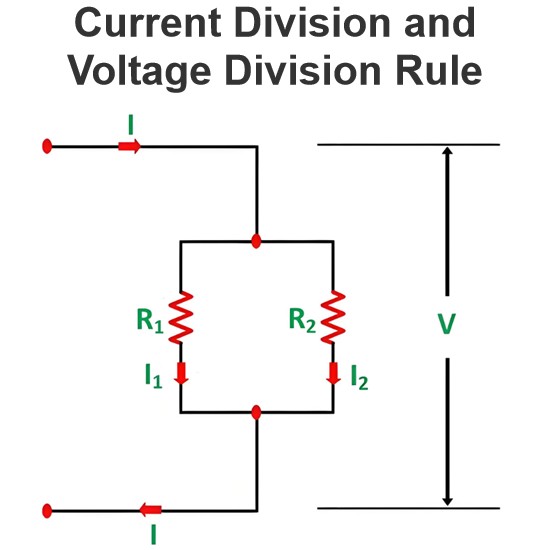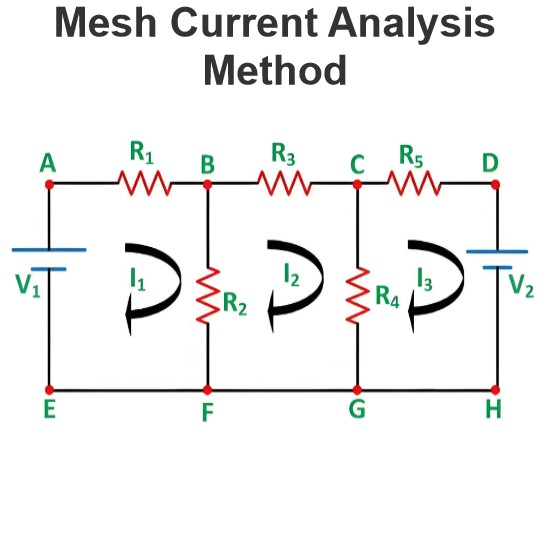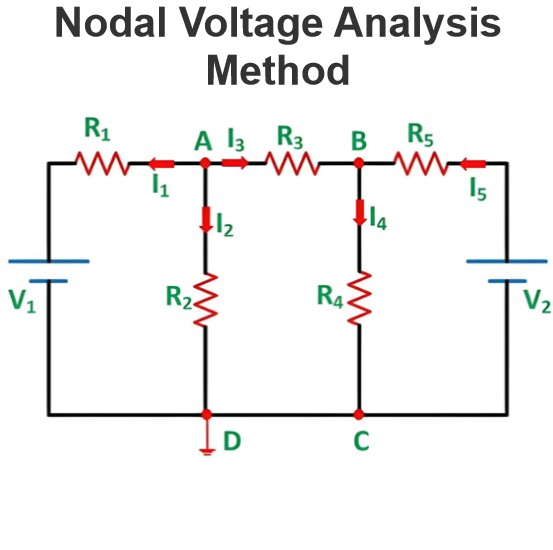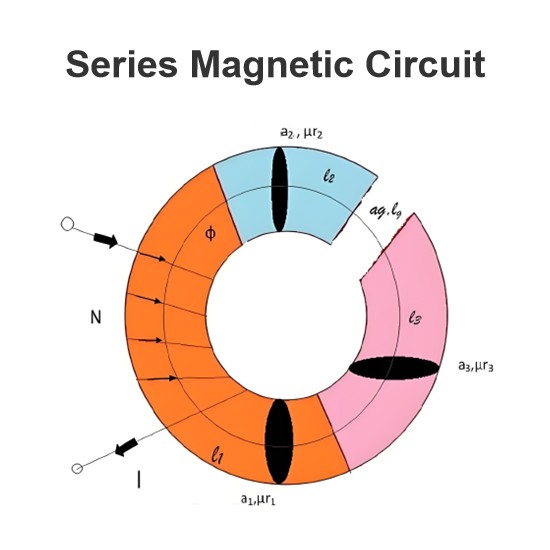RC Circuit Analysis: Series, Parallel, Equations & Transfer Function
What is an RC Circuit?
An RC circuit (also known as an RC filter or RC network) stands for a resistor-capacitor circuit. An RC circuit is defined as an electrical circuit composed of the passive circuit components of a resistor (R) and capacitor (C), driven by a voltage source or current source.
Due to the presence of a resistor in the ideal form of the circuit, an RC circuit will consume energy, akin to an RL circuit or RLC circuit.
This is unlike the ideal form of an LC circuit, which will consume no energy due to the absence of a resistor. Although this is only in the ideal form of the circuit, and in practice, even an LC circuit will consume some energy because of the non-zero resistance of the components and connecting wires.
Series RC Circuit
In an RC series circuit, a pure resistor having resistance R in ohms and a pure capacitor of capacitance C in Farads are connected in series.

SERIES R-C CIRCUIT
Here ![]() is the RMS value of the current in the circuit.
is the RMS value of the current in the circuit.
![]() is the voltage across the resistor R.
is the voltage across the resistor R.
![]() is the voltage across the capacitor C.
is the voltage across the capacitor C.
![]() is the RMS value of the supply voltage.
is the RMS value of the supply voltage.
The figure shows a vector diagram of the series RC circuit.

VECTOR DIAGRAM
Since in a series circuit current ![]() is the same so it is taken as a reference.
is the same so it is taken as a reference.
![]() is drawn in phase with current
is drawn in phase with current ![]() because in a pure resistor the voltage and current are in phase with each other.
because in a pure resistor the voltage and current are in phase with each other.
![]() is drawn lagging with current
is drawn lagging with current ![]() by
by ![]() because in a pure capacitor voltage and current are
because in a pure capacitor voltage and current are ![]() out of each other i.e. voltage lags current by
out of each other i.e. voltage lags current by ![]() or current leads the voltage by
or current leads the voltage by ![]() .
.
Now ![]() is the vector sum of
is the vector sum of ![]() and
and ![]() .
.
The impedance of an R-C series circuit is
The voltage and impedance triangle are shown in figure.

As seen, the vector ![]() lags
lags ![]() by an angle ø where
by an angle ø where
Thus in an R-C series circuit current ![]() leads the supply voltage
leads the supply voltage ![]() by an angle
by an angle
The voltage and current waveforms of the R-C series circuit are shown in fig.

VOLTAGE AND CURRENT WAVEFORM
Power in an RC Series Circuit
The instantaneous value of the power is the product of the instantaneous values of the voltage and current.
Thus the instantaneous power consists of two parts.
1. A constant part = ![]()
2. A varying component = ![]() which varies at twice the supply frequency.
which varies at twice the supply frequency.
The average value of the varying power component over a complete cycle is zero.
Thus the average power consumed in an RC series circuit over one cycle is

Where ![]() and
and ![]() are the RMS values of the applied voltage and current in the circuit.
are the RMS values of the applied voltage and current in the circuit.
Power Factor in an RC Series Circuit
Consider the figure showing the power and impedance triangles.


Parallel RC Circuit
In a parallel R-C circuit a pure resistor having resistance ![]() in ohms and a pure capacitor of capacitance
in ohms and a pure capacitor of capacitance ![]() in Farads are connected in parallel.
in Farads are connected in parallel.

PARALLEL R-C CIRCUIT
Voltage drops in a parallel RC circuit are the same hence the applied voltage is equal to the voltage across the resistor and voltage across the capacitor. Current in a parallel R-C circuit is the sum of the current through the resistor and capacitor.
For the resistor, current through it given by ohm’s law:
The voltage-current relationship for the capacitor is:
Applying KCL (Kirchhoff’s Current Law) to parallel R-C circuit
Above equation is the first-order differential equation of an R-C circuit.
Transfer Function of the Parallel RC Circuit:
RC Circuit Equations
Capacitor C behaves as a ![]() in the frequency domain with a voltage source of
in the frequency domain with a voltage source of ![]() in series with it where
in series with it where ![]() is the initial voltage across the capacitor.
is the initial voltage across the capacitor.
Impedance: The complex impedance, ![]() of a capacitor C is
of a capacitor C is
![]() represents the imaginary part
represents the imaginary part ![]()
![]() represents sinusoidal angular frequency (radians per second)
represents sinusoidal angular frequency (radians per second)
Current: The current is same everywhere in series R-C circuit.
Voltage: By applying the voltage divider rule, the voltage across the capacitor is:

and the voltage across the resistor is:
RC Circuit Current
The current is the same everywhere in the series R-C circuit.
Transfer Function of RC Circuit
The transfer function from the input voltage to the voltage across the capacitor is
Similarly, the transfer function from the input voltage to the voltage across the resistor is
Step Response of RC Circuit
When something changes in a circuit, as a switch closes, the voltage and current also change and adjust to the new conditions. If the change is an abrupt step the response is called the step response.
The total response of a circuit is equal to the forced response plus natural response. These responses can be combined using the principle of superposition.
The forced response is one in which source of supply is turned on but with the initial conditions (internally stored energy) assumed to be zero.
The natural response is one in which source of supply is turned off but the circuit does including the initial conditions (initial voltage on capacitors and current in inductors). The natural response is also called the zero input response because the source of supply is turned off.
Therefore, total response = forced response + natural response
What is an Initial Condition?
In the case of an inductor, the current through it cannot be changed instantaneously. That means the current through inductor at instant ![]() will remain same just after transition at instant
will remain same just after transition at instant ![]() . i.e.,
. i.e.,
In the case of a capacitor, the voltage across the capacitor cannot be changed instantaneously. That means the voltage across the capacitor at instant ![]() will remain the same just after transition at instant
will remain the same just after transition at instant ![]() . i.e.,
. i.e.,
Forced Response of Driven Series RC Circuit
Let us assume that the capacitor is initially fully discharged and switch (K) is kept open for a very long time and it is closed at ![]() .
.

At ![]() switch K is open
switch K is open
This is an initial condition hence we can write,
Because the voltage across the capacitor cannot change instantaneously.
For all
 switch K is closed.
switch K is closed.
Now the voltage source is introduced in the circuit. Hence applying KVL to the circuit, we get,
Now i(t) is the current through the capacitor and it can be expressed in terms of voltage across capacitor as
Substitute this into equation (2), we get,
Separating variables, we get
Integrating both the sides
Where ![]() is the arbitrary constant
is the arbitrary constant
To find ![]() : Using initial condition i.e. substituting equation (1) into equation (3), we get,
: Using initial condition i.e. substituting equation (1) into equation (3), we get,
Substituting value of K’ in equation (3) we get,
Taking antilog, we get,
The above equation indicates the solution of a first-order differential equation of a series R-C circuit.
The above response is a combination of steady-state response i.e. ![]()
and transient response i.e. ![]()
Natural Response of Source Free Series RC Circuit
The source free response is the discharge of a capacitor through a resistor in series with it.

For all ![]() switch K is closed
switch K is closed
Applying KVL to the above circuit, we get,
Substitute this value of current into equation (6), we get,
Separating variables, we get
Integrating both the sides
Where ![]() is arbitrary constant
is arbitrary constant
To find ![]() : Using initial condition i.e. substituting equation (1) into equation (7), we get,
: Using initial condition i.e. substituting equation (1) into equation (7), we get,
Substituting the value of ![]() in equation (7) we get,
in equation (7) we get,
Taking antilog, we get,
The above equation indicates the natural response of the series RC circuit.
Now, total response = forced response + natural response
Where, ![]() is the step voltage.
is the step voltage.
![]() is the initial voltage on the capacitor.
is the initial voltage on the capacitor.
Time Constant of RC Circuit
The time constant of an R-C circuit can be defined as the time during which the voltage across the capacitor would reach its final steady-state value.
One time constant is the time required for the voltage to rises 0.632 times steady-state value or time required for the current to decay 0.368 times the steady-state value.
The time constant of the R-C circuit is the product of resistance and capacitance.
Its unit is second.
RC Circuit Frequency Response

R-C CIRCUIT
Using Impedance method: General equation for frequency response system is
Now apply potential divider rule to the above circuit
Where, ![]() = Impedance of capacito
= Impedance of capacito
Substitute this in equation (10), we get,


The above response is a frequency response of an R-C circuit in complex form.
RC Circuit Differential Equation
RC Charging Circuit Differential Equation
Voltage across capacitor is given by
Now current through the capacitor is given by
RC Discharging Circuit Differential Equation
The voltage across the capacitor is given by
Now current through the capacitor is given by
RC Circuit Charging and Discharging
RC Circuit Charging

R-C CHARGING CIRCUIT
The figure shows the simple R-C circuit in which capacitor (C), in series with a resistor (R) that is connected to the DC voltage source via a mechanical switch (K). The capacitor is initially uncharged. When switch K is closed, the capacitor will gradually charge up through the resistor until the voltage across the capacitor becomes equal to the supply voltage source. The charge on the plates of the capacitor is given as Q = CV.
From the above equation, it is clear that the capacitor voltage increases exponentially.
Where,
 is the voltage across the capacitor
is the voltage across the capacitor is the supply voltage.
is the supply voltage.
RC is the time constant of the RC charging circuit. i.e. ![]()
Let us substitute different values of time t in equation (11) and (12),we get capacitor charging voltage, i.e.
and capacitor charging current
The variation of voltage across the capacitor ![]() and current through capacitor
and current through capacitor ![]() as a function of time is shown in the figure.
as a function of time is shown in the figure.

Variation of Voltage Vs Time

Variation of Current Vs Time
Thus in R-C charging circuit if the voltage across the capacitor rises exponentially, the current through capacitor decays exponentially with the same rate. When the voltage across the capacitor reaches the steady-state value, the current decreases to zero value.
RC Circuit Discharging
If fully charged capacitor is now disconnected from the battery supply voltage, the stored energy in the capacitor during the charging process would stay indefinitely on its plates, keeping the voltage stored across its terminals at a constant value.
Now if the battery was replaced by a short circuit and when the switch is closed the capacitor will discharge through the resistor, now we have a circuit called RC discharging circuit.

R-C DISCHARGING CIRCUIT
From the above equation, it is clear that the capacitor voltage decreases exponentially. That means in discharging the R-C circuit, the capacitor discharges through resistor R in series with it. Now the time constant of R-C charging circuit and R-C discharging circuit are same and is
Let us substitute different values of time t in equation (13) and (14),we get capacitor discharging voltage, i.e.
The variation of voltage across the capacitor ![]() as a function of time is shown in the figure.
as a function of time is shown in the figure.

Variation of Voltage Vs Time
Thus in the R-C Discharging circuit, similarly if the voltage across the capacitor decreases exponentially, the current through the capacitor rises exponentially with the same rate. When the voltage across the capacitor reaches zero value, the current reaches a steady-state value.
Statement: Respect the original, good articles worth sharing, if there is infringement please contact delete.
Electrical4U is dedicated to the teaching and sharing of all things related to electrical and electronics engineering.














